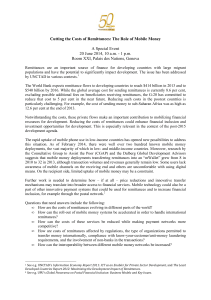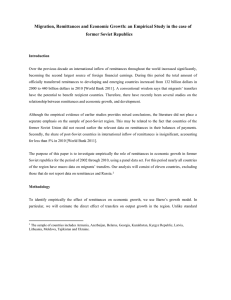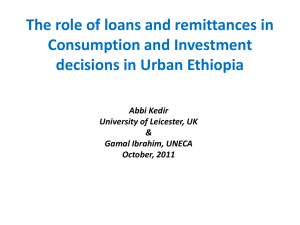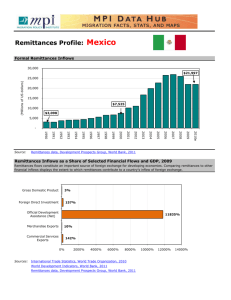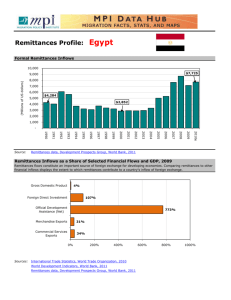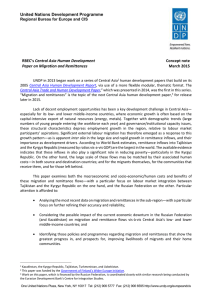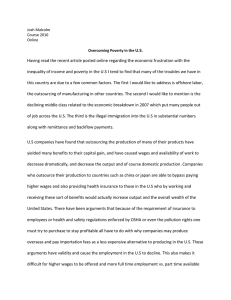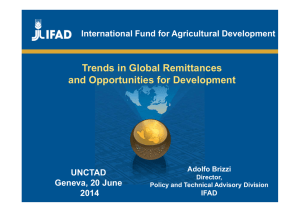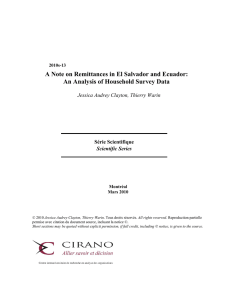Terms of Reference
advertisement
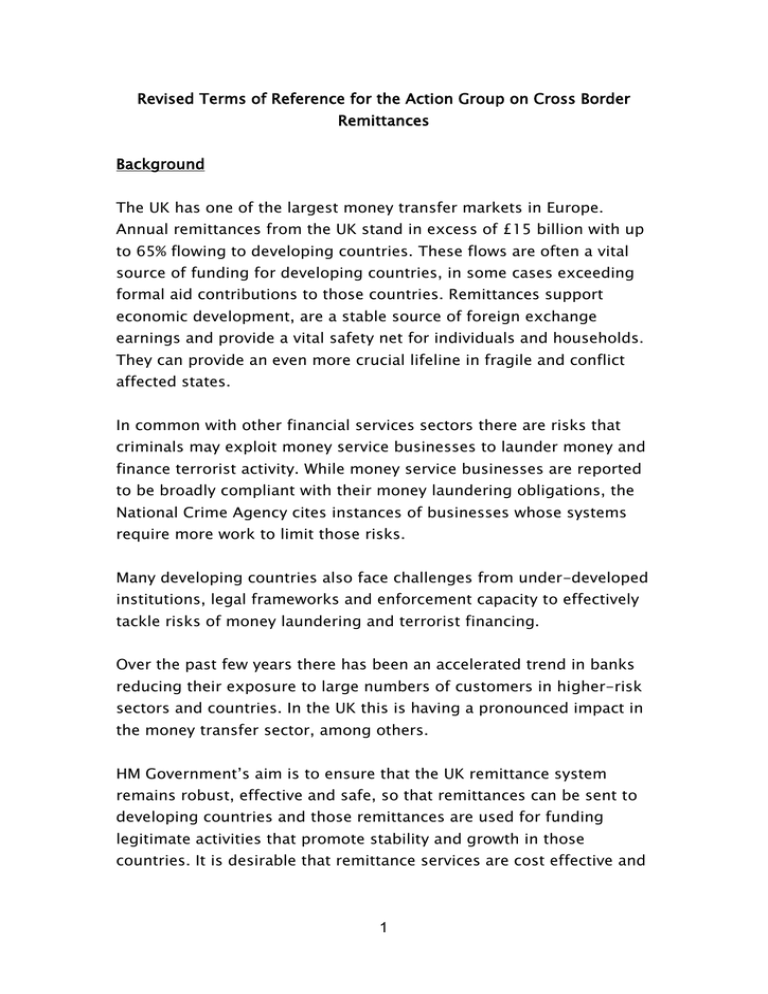
Revised Terms of Reference for the Action Group on Cross Border Remittances Background The UK has one of the largest money transfer markets in Europe. Annual remittances from the UK stand in excess of £15 billion with up to 65% flowing to developing countries. These flows are often a vital source of funding for developing countries, in some cases exceeding formal aid contributions to those countries. Remittances support economic development, are a stable source of foreign exchange earnings and provide a vital safety net for individuals and households. They can provide an even more crucial lifeline in fragile and conflict affected states. In common with other financial services sectors there are risks that criminals may exploit money service businesses to launder money and finance terrorist activity. While money service businesses are reported to be broadly compliant with their money laundering obligations, the National Crime Agency cites instances of businesses whose systems require more work to limit those risks. Many developing countries also face challenges from under-developed institutions, legal frameworks and enforcement capacity to effectively tackle risks of money laundering and terrorist financing. Over the past few years there has been an accelerated trend in banks reducing their exposure to large numbers of customers in higher-risk sectors and countries. In the UK this is having a pronounced impact in the money transfer sector, among others. HM Government’s aim is to ensure that the UK remittance system remains robust, effective and safe, so that remittances can be sent to developing countries and those remittances are used for funding legitimate activities that promote stability and growth in those countries. It is desirable that remittance services are cost effective and 1 make maximum use of formal payment channels where it is possible to do so, taking into account regulatory expectations. On 27 September 2013 the Government hosted a Roundtable on Securing the Future of the UK Remittances Market, which agreed a set of government and supervisor actions. The first of these was to establish an Action Group on Cross Border Remittances, which met monthly throughout 2014. In December 2014 the Action Group agreed to extend its remit for a further year - the group will continue to meet monthly throughout 2015. This Terms of Reference document has been updated to reflect the extension of the Action Group’s remit. Structure and Membership Members of the Action Group are appointed at the invitation of the HMG Steering Group on Remittances. Membership is drawn from a cross section of industry, regulators, civil society and international partners. Additional experts are invited to attend meetings as guest members on an ad hoc basis. The roles are non-remunerated. The Action Group meets on a monthly basis. The structure of the Action Group is as follows: Steering Group Composed of officials from the Cabinet Office (CO); the Department for International Development (DfID); the Financial Conduct Authority (FCA); the Foreign & Commonwealth Office (FCO); HM Revenue & Customs (HMRC); HM Treasury (HMT), National Terrorist Financing Investigation Unit (NTFIU) and the National Crime Agency (NCA).The Steering Group meets fortnightly. Each department should send a representative to every Steering Group meeting. Non-Executive Chair Sir Brian Pomeroy CBE Action Group 2 Composed of the HMG Steering Group members and representatives from; the World Bank; the International Association of Money Transfer Networks (IAMTN); the Association of UK Payments Institutions (AUKPI); the British Bankers’ Association (BBA); European Payments Institutions Federation (EPIF); the Charity Finance Group and Consumers International. The Chair is responsible for chairing and managing the work of the Action Group. The Chair will report to the HMG Steering Group and meet with it on a monthly basis. Action Group Secretariat duties are shared among Steering Group members on a rotational basis. This includes liaising with Chair and Steering Group to prepare the agenda, hosting the meeting, minutetaking, drafting a Chair’s summary of the meeting, signing off minutes and summary with the Chair and distributing minutes. DfID are responsible for uploading the Chair’s summary of the meeting onto the Action Group’s webpage (https://www.gov.uk/government/policies/helping-developingcountries-economies-to-grow/supporting-pages/enabling-thecontinued-flow-of-remittances) on a monthly basis. If any perceived conflict of interest arises in the operation of the Action Group, the appropriate Government department will liaise with relevant stakeholders to resolve the issue. All such issues will be noted by the HMG Steering Group. Working Groups Safer Corridors for the UK-Somalia corridor (led by DfID and implemented by the World Bank) Risk (led by NCA) Technical capability Market monitoring (led by HMT). 3 The coordinators of each working group are responsible for devising terms of reference for their work. Each of the working groups provides monthly updates to the Action Group on progress against targets and deliverables set out in their respective terms of reference. Objectives The Action Group serves as a mechanism to maintain continued crosssector dialogue on the withdrawal of banking services from the money service business sector in order to rebuild trust in the sector and enable remittances to continue to flow. The specific objectives of the Action Group are to: Monitor developments in the UK remittances market, including decisions by formal banking institutions, the impact of new technologies and remittance flows; Work with law enforcement and industry to promote a shared understanding of the risk that the MSB sector represents; Oversee the development of a safer corridor pilot for the UKSomalia corridor. Advise on any relevant technical issues affecting remittances. The Action Group may undertake additional relevant activities if proposed by the Chair, subject to agreement by the Steering Group. Communications The Chair (with support from the FCO) will be responsible for public communications from the Action Group to identified stakeholder groups and for developing a strategic communications plan. 4 Annex A: Progress of the Action Group during 2014 Oversaw the production of guidance for financial institutions providing banking facilities to MSBs and separately, guidance for MSBs themselves on how to comply with AML/CTF obligations. The guidance aims to promote the adoption of best practice standards in the industry, and to reassure banks that MSBs are effectively supervised. Guidance is an essential part of the UK’s risk-based approach to anti-money-laundering, allowing firms to take a targeted and proportionate approach, following the expert guidance, and not fear of prosecution. Guidance provides a legal ‘safe-harbour’ for regulated firms, should a supervisor wish to impose a civil penalty, or in the event of a prosecution, the supervisor or firm must consider whether the firm or individual concerned followed relevant guidance before deciding whether or not they will be penalised. Oversaw the design of a safer corridor pilot for UK-Somalia remittances The safer corridor pilot is a series of coordinated interventions at each key stage of the remittance transaction the First Mile (MSB in the UK takes the money), the Second Mile (clearing house in the UAE) and the Last Mile (end destination in Somalia.) The pilot’s objective is to ensure the continued, secure flow of remittances to Somalia and to rebuild the confidence of banks to engage with the market and encourage them to continue support transactions beyond the pilot. Led by the Department for International Development and implemented by the World Bank, the design phase of the pilot will be completed by the end of 2014, it is the intention that the 5 first transactions will flow through the corridor during Q2 of 2015. Held a series of closed workshops facilitated by the BBA, the UK Money Transmitters Association (now AUKPI) and SOMSA to develop a shared understanding of risk in the UK remittances market and the key drivers for ‘de-risking’ in this sector. 6

